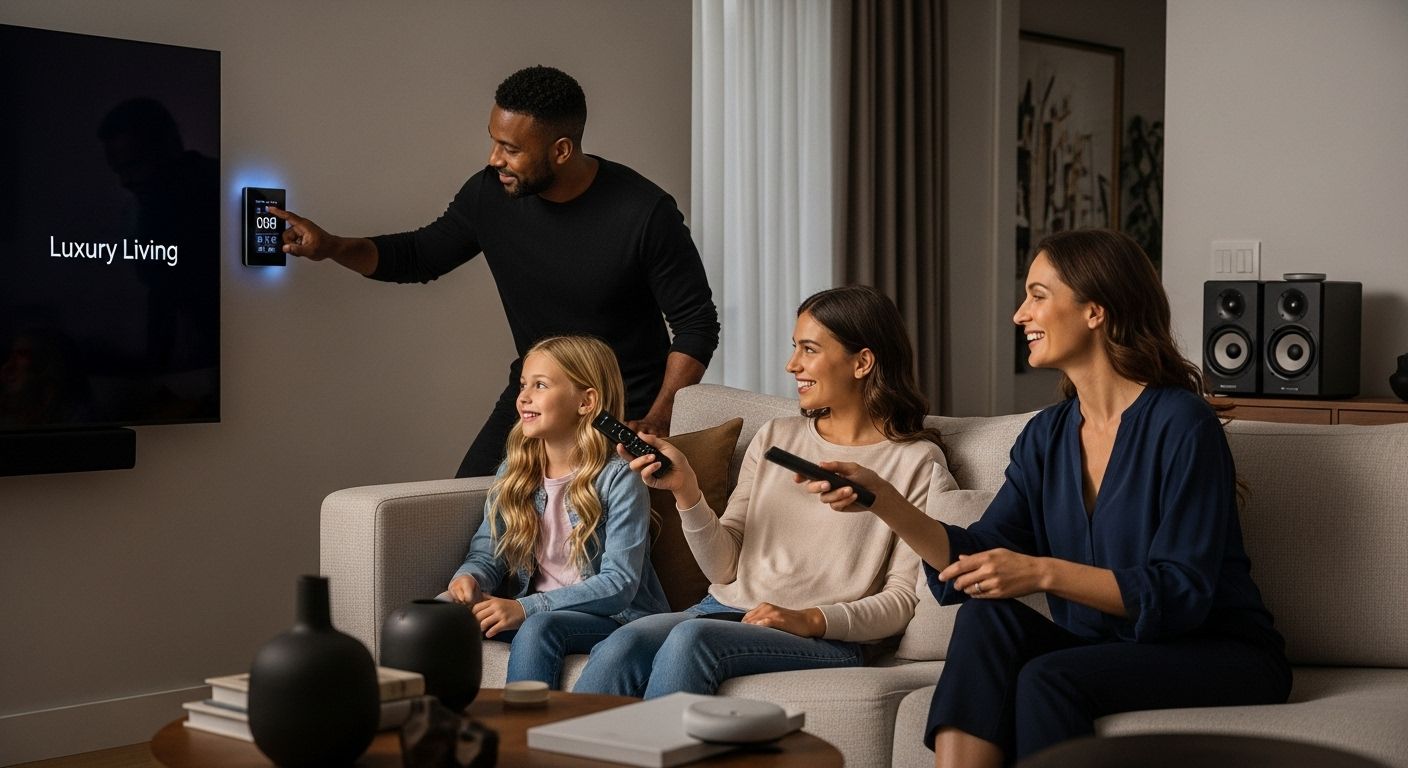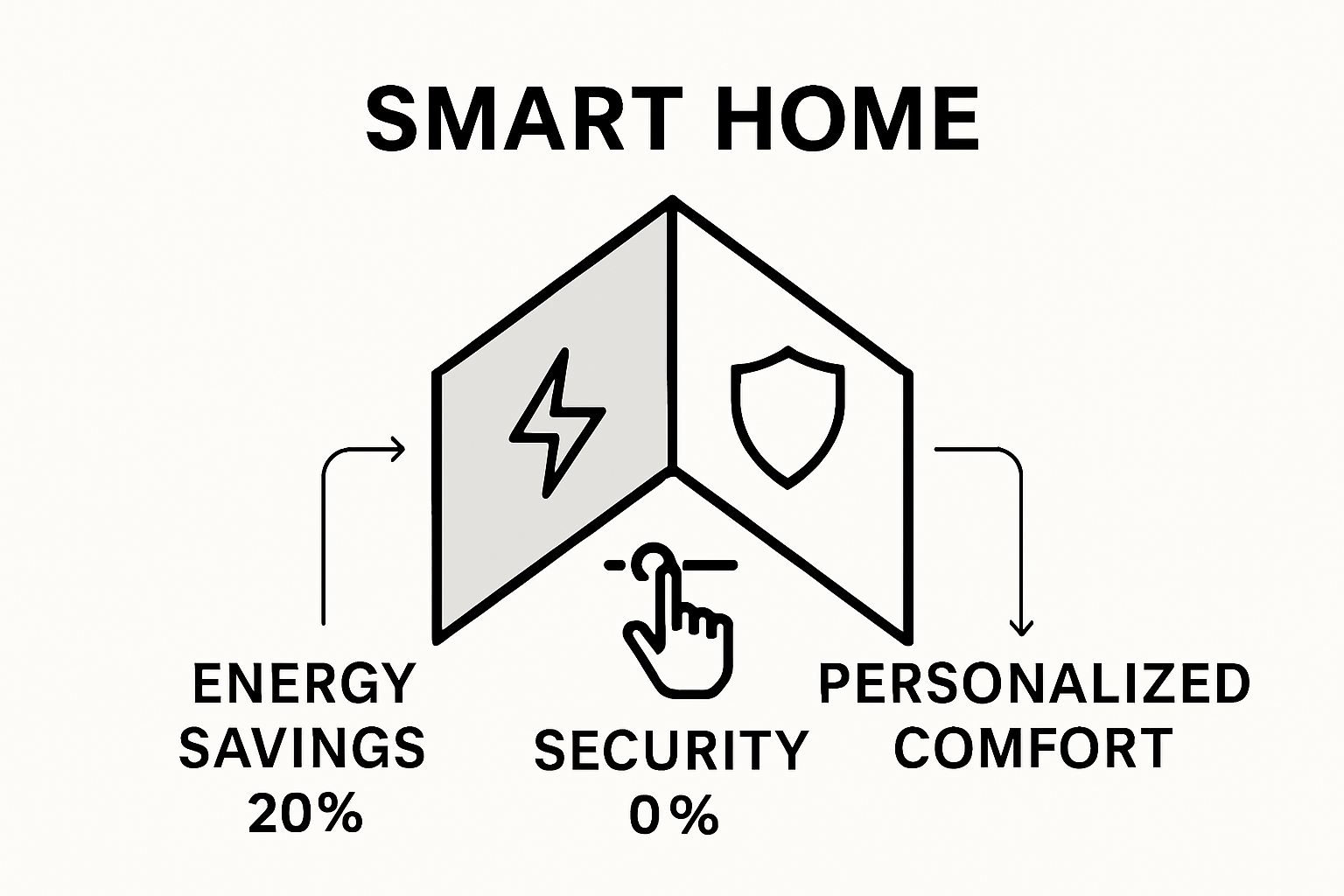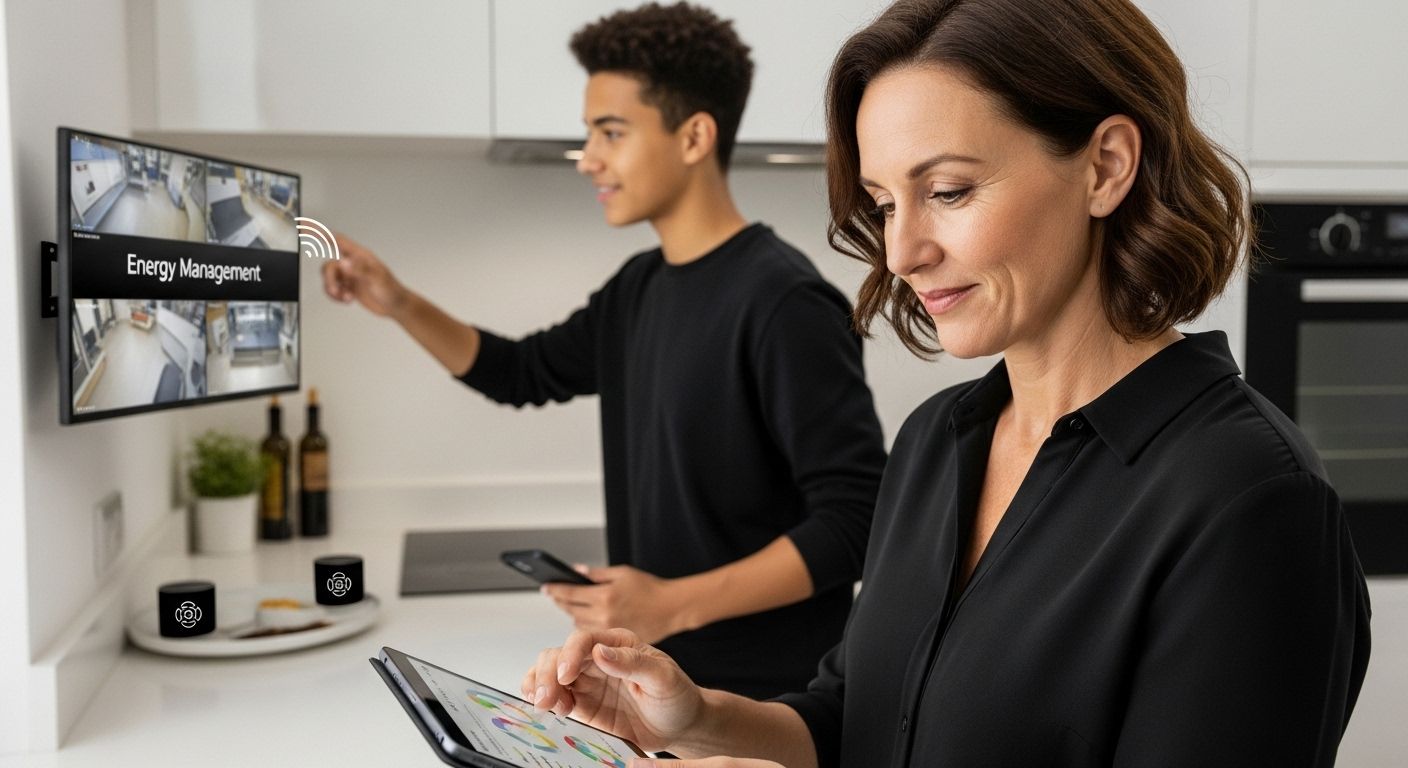Understanding Smart Home Pros: The Future of Luxury Living
- garygarihanjr
- Sep 3
- 9 min read

Smart home technology is changing the way people live, turning ordinary houses into intelligent spaces that respond to your needs. Many think these upgrades are just about convenience or luxury, but the reality goes way deeper. In fact, IoT-based home automation can significantly cut energy bills and improve security all at once. What surprises most people is how these innovations actually make life simpler, safer, and more personal for everyone, not just tech lovers.
Table of Contents
Quick Summary
Takeaway | Explanation |
Smart homes enhance daily living. | Integrated technology creates responsive environments that cater to individual preferences and needs. |
Energy management reduces costs. | Devices like smart thermostats optimize energy use, saving homeowners money on utility bills. |
Advanced security systems offer peace of mind. | Real-time monitoring and automated alerts protect homes, enhancing overall safety and awareness. |
Customization creates personalized comfort. | Homeowners can tailor lighting and climate settings to match their unique lifestyles effortlessly. |
User-centered design prioritizes ease of use. | Effective smart home systems are intuitive, making technology accessible for all users regardless of experience level. |
What is Smart Home Technology and Why Does It Matter?
Smart home technology represents a transformative approach to residential living that seamlessly integrates advanced digital solutions into everyday home environments. By connecting various household devices and systems through internet-enabled networks, smart homes create intelligent living spaces that respond dynamically to residents’ needs and preferences.
Understanding the Core Concept
At its essence, smart home technology transforms traditional residential spaces into interactive, responsive environments. These systems utilize interconnected devices that communicate across wireless networks, enabling homeowners to monitor, control, and automate multiple aspects of their living spaces. According to research from the Bipartisan Policy Center, smart homes can include Internet-enabled devices such as:
Lighting systems that adjust automatically
Security cameras with remote monitoring
Smart locks and access control mechanisms
Intelligent climate control systems
Voice-activated digital assistants
These technologies go beyond simple convenience, offering significant benefits like enhanced energy efficiency, improved security, and personalized living experiences.
To clarify the main features of smart home technology, the table below outlines key components described in the article and summarizes their roles in the smart home ecosystem.
Feature / Component | Description | Example Use Case |
Smart Lighting | Adjusts brightness and color automatically or by user preferences | Lights dim or brighten by time of day |
Security Cameras & Monitoring | Provides real-time surveillance and remote monitoring | View home entry from a smartphone |
Smart Thermostats | Automatically manages heating and cooling for energy savings | Changes temperature when residents leave |
Smart Locks & Access Control | Controls entry points remotely and tracks access events | Unlock doors for guests remotely |
Voice-Activated Digital Assistants | Allows hands-free control of devices and scenes | Use voice to set mood lighting |
Automated Window Treatments | Adjusts blinds or shades in response to sunlight or schedule | Lowers blinds in afternoon sunlight |
Smart Music & Entertainment Systems | Synchronizes audio across multiple rooms and automates playback | Start playlist in kitchen and living |
The Practical Impact of Smart Home Solutions
Beyond technological novelty, smart home systems provide tangible advantages for modern homeowners. Energy management becomes more precise, with devices like smart thermostats automatically adjusting temperatures based on occupancy and personal preferences. Security is dramatically enhanced through integrated systems that allow real-time monitoring and instant alerts. For individuals with mobility challenges or those seeking greater independence, these technologies offer unprecedented levels of home control and assistance.
The following table compares how smart home solutions enhance both energy management and security, detailing their practical impacts on modern households as discussed in the article.
Solution Area | Example Technologies | Practical Benefit | Impact on Homeowners |
Energy Management | Smart thermostats, smart lighting | Reduces energy usage by optimizing consumption | Lower utility bills, less waste |
Security | Security cameras, smart locks | Enhances safety through monitoring and instant alerts | Greater peace of mind, remote control |
Custom Comfort | Climate zones, automated shades | Personalizes environment for user preferences | More convenience, luxury feel |
Accessibility | Voice assistants, app controls | Makes control easier for all household members | Increased independence |
For those interested in exploring how these technologies can transform residential spaces, learn more about advanced home automation solutions.
Ultimately, smart home technology represents more than just a trend it signifies a fundamental reimagining of how we interact with our living environments, making homes more responsive, efficient, and tailored to individual needs.
The Benefits of Smart Home Pros: Enhancing Luxury and Convenience
Smart home technologies represent far more than mere technological novelties they are comprehensive solutions designed to elevate residential experiences by seamlessly integrating advanced digital capabilities into everyday living environments. These sophisticated systems transform traditional homes into intelligent, responsive spaces that anticipate and fulfill residents’ needs with unprecedented precision and elegance.
Personalized Comfort and Unprecedented Control
The hallmark of smart home technology lies in its ability to deliver personalized living experiences. Modern smart home systems allow homeowners to create custom environments tailored to individual preferences. Whether adjusting lighting, temperature, or sound systems, residents can program precise settings that adapt automatically throughout the day. According to research from Luxury Living Tech Insights, high-end residential technologies now offer features like:
Ambient lighting that changes based on time of day
Climate zones with individualized temperature controls
Music and entertainment systems synchronized across multiple rooms
Automatic window treatments that respond to sunlight intensity
Voice-activated environmental controls
These innovations translate complex technological capabilities into seamless, intuitive interactions that prioritize user comfort and convenience.

Advanced Security and Energy Management
Beyond comfort, smart home technologies provide robust security and energy efficiency solutions. Integrated security systems now offer real-time monitoring, remote access control, and instant alerts that significantly enhance residential safety. Energy management becomes intelligent and proactive, with systems that learn household patterns and automatically optimize power consumption.
Discover how advanced home automation can revolutionize your living space, transforming not just how you interact with your home, but fundamentally improving your quality of life.
Ultimately, smart home technologies represent a quantum leap in residential design, bridging the gap between cutting-edge technology and luxurious, personalized living environments.
How Smart Automation Works: The Technology Behind the Scenes
Smart home automation represents a sophisticated technological ecosystem where multiple digital components communicate seamlessly to create intelligent, responsive living environments. This intricate network transforms traditional residential spaces into dynamic systems capable of learning, adapting, and anticipating user needs with remarkable precision.
Core Communication Infrastructure
At the heart of smart home technology lies a complex wireless communication network that enables different devices to interact and exchange information. These systems typically utilize protocols like WiFi, Bluetooth, Zigbee, and Z Wave, allowing devices from various manufacturers to communicate effectively. According to research from IoT Technology Insights, the key technological components include:
Sensors that collect environmental data
Central processing units for decision making
Wireless communication modules
Cloud based storage and analysis platforms
User interface applications
Each device functions as an intelligent node within this interconnected network, continuously collecting and sharing data to optimize home functionality.
Intelligent Decision Making and Machine Learning
Modern smart home systems employ advanced machine learning algorithms that enable devices to understand and predict user behaviors. By analyzing historical usage patterns, these systems can automatically adjust settings like temperature, lighting, and security protocols. The technology goes beyond simple programmable routines it creates adaptive environments that learn and respond to residents’ unique preferences.
Explore the cutting edge of home automation technologies and discover how intelligent systems are redefining residential living experiences.
Ultimately, smart home automation represents a sophisticated fusion of hardware, software, and artificial intelligence that transforms residential spaces into responsive, intelligent ecosystems tailored to individual lifestyles.
Key Concepts in Smart Home: Integration and Usability
Smart home design transcends mere technological implementation it represents a holistic approach to creating living environments that seamlessly blend advanced technology with human experience. The ultimate goal is developing systems that are not just technologically sophisticated, but intuitively responsive to individual user needs and preferences.
User Centered Architecture
The foundation of effective smart home design lies in human centered architectural principles. These principles prioritize creating technology that adapts to human behaviors rather than forcing users to adapt to technological constraints. According to research from the Rocky Mountain College of Art + design, successful smart home design requires careful consideration of:
Intuitive interface design
Seamless device compatibility
Personalization capabilities
Accessibility for diverse user abilities
Scalable technological frameworks
By focusing on user experience, designers can create systems that feel natural and enhance rather than complicate daily living.
Comprehensive Integration Strategies
Successful smart home design demands sophisticated integration strategies that enable disparate technologies to communicate effortlessly. This involves developing robust communication protocols that allow devices from different manufacturers to interact smoothly, creating a unified ecosystem. Advanced integration goes beyond technical compatibility it creates an environment where technology becomes an invisible, supportive layer of daily life.
Discover advanced strategies for seamless home technology integration, and learn how modern design approaches are transforming residential experiences.
Ultimately, smart home design represents a sophisticated dialogue between human needs, technological capabilities, and architectural innovation creating living spaces that are responsive, intelligent, and profoundly personal.
Real-World Applications of Smart Home Solutions for Homeowners
Smart home solutions have evolved from futuristic concepts to practical, everyday technologies that provide tangible benefits across various aspects of residential living. These innovative systems are no longer just luxury add ons but essential tools that enhance safety, efficiency, and quality of life for modern homeowners.
Energy Management and Cost Optimization
One of the most compelling real world applications of smart home technology is intelligent energy management. According to research published in the National Center for Biotechnology Information, IoT based home automation systems can significantly reduce energy consumption and utility costs. These systems offer homeowners precise control and monitoring capabilities, including:
Automated temperature regulation
Smart lighting that adjusts based on occupancy
Real time energy consumption tracking
Predictive maintenance alerts for home appliances
Personalized energy efficiency recommendations
By leveraging advanced sensors and machine learning algorithms, these technologies can dramatically reduce household energy expenses while minimizing environmental impact.

Enhanced Home Security and Monitoring
Smart home solutions have revolutionized residential security, transforming traditional protection methods into sophisticated, interconnected systems. Homeowners can now monitor their properties remotely, receive instant alerts, and implement comprehensive security protocols with unprecedented ease. Modern smart security systems integrate multiple technologies to provide comprehensive protection, including video surveillance, motion detection, and automated access control.
Explore comprehensive home automation solutions that can transform how you interact with and secure your living space.
Ultimately, smart home technologies represent more than technological innovations they are sophisticated tools designed to simplify, secure, and enhance the residential experience, providing homeowners with unprecedented control and peace of mind.
Bring the Future of Luxury Home Living to Your Own Space
Are you impressed by the possibilities of smart home technology in delivering personalized comfort, advanced security, and seamless integration described in “Understanding Smart Home Pros: The Future of Luxury Living”? The article explored how adapting your residence with intelligent automation can solve the pain points of everyday inconvenience, complicated controls, and underwhelming security. Many readers recognize the advantage of transforming routine home experiences—yet wonder how to achieve this level of effortless luxury with solutions tailored just for them.

This is where Techology Experts steps in. Our team specializes in designing and installing custom smart home systems and luxury home theaters that align precisely with your lifestyle goals. Looking for a solution that adapts to your habits, enhances your daily comfort, and secures your home? We deliver every aspect, from intuitive home automation installations to bespoke, region-specific support for Houston’s most discerning homeowners. Do not wait to experience the ultimate in home technology. Visit our main site now and take the first step toward experiencing the future of luxury living in your own home.
Frequently Asked Questions
What are the main benefits of using smart home technology?
Smart home technology offers enhanced energy efficiency, improved security, and personalized living experiences by automating and connecting household devices.
How does smart home automation improve residential security?
Smart home automation enhances security through integrated systems that allow for remote monitoring, instant alerts, and video surveillance, providing homeowners with comprehensive protection.
Can smart home devices learn user preferences?
Yes, modern smart home systems employ machine learning algorithms that analyze user behavior to adapt settings like temperature and lighting according to individual preferences.
What types of devices are commonly found in a smart home?
Common devices in a smart home include smart thermostats, security cameras, lighting systems, smart locks, voice-activated assistants, and climate control systems.
Recommended
Comments